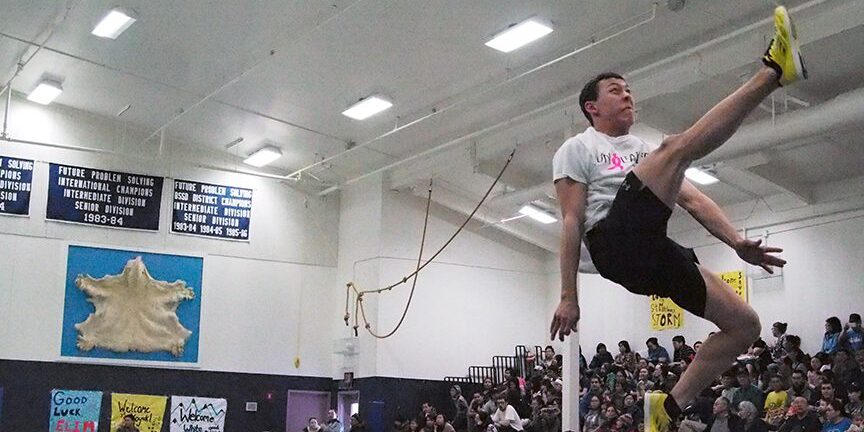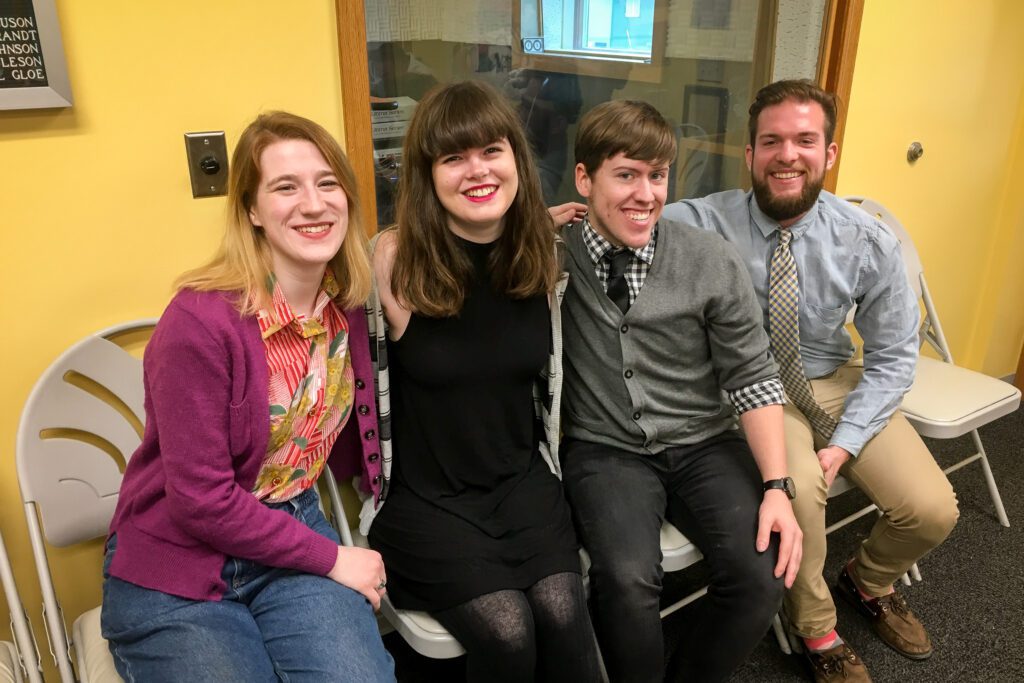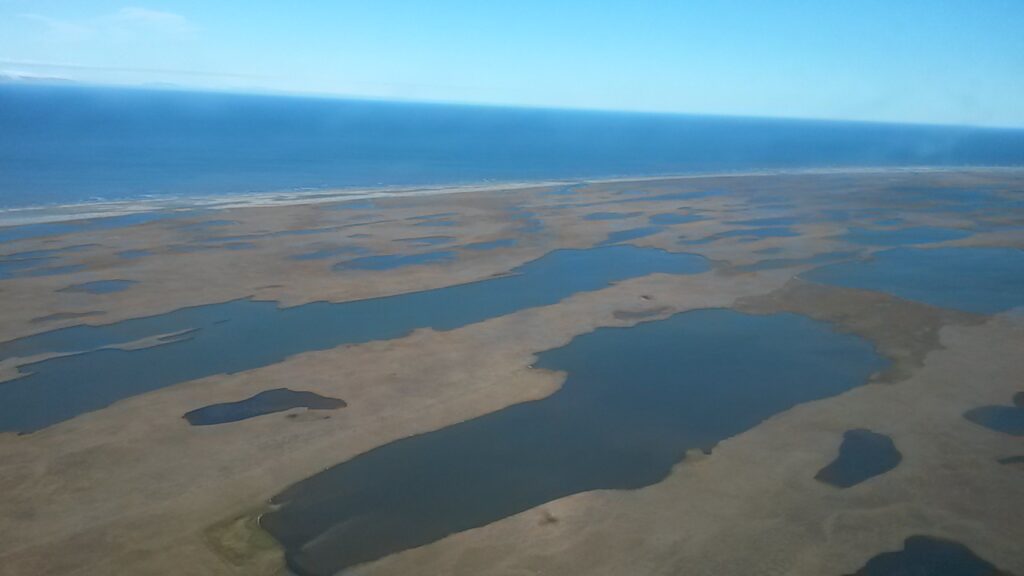This post is very late. When I started it I was sitting on the floor of the gym in Gambell, watching half a dozen coaches lay measuring tape for the last event of the Bering Straits School District’s Native Youth Olympics tournament, the Seal Hop.
Four girls hopped on their palms and tippy-toes. Seal Hop is a race where each step is a bouncing push-up forward. For as far as you can go, until you collapse. Gambell’s school mascot is the Qughsatik, king polar bears. There’s a polar bear hide the size of a studio apartment mounted on the wall, just right of the basketball hoop.
I went for a story on the tournament, and about what the Native Youth Olympics mean in a community like Gambell and a region like the Bering Straits. My friend Marjorie joined to provide context, help with interviews, and offer expert analysis on both the games and the traditional activities they refer back to. The events we watched—one-foot high kick, seal hop, stick pull, more—are codified versions of strength building exercises and dexterity demonstrations practiced more casually in the not-so-distant past. The high kicks, as best anyone knows, were signals between whalers before radio equipment.
By the time I got home to Nome on Friday evening I was drained—emotionally, physically, all of it. I had just about enough energy to make Tara fried buffalo wings for her birthday and then needed to spend some time brooding on mute to re-coop a semblance of solidity. My head and appendages felt like porridge.
The reason I was tired was that it was a full trip, and I was in it fully. Reporting-wise I did my best job yet of getting interviews with coaches and athletes, largely because Marjorie knew exactly the right people to pester, and prodded me into going up to them. There was physical discomfort from sitting on hard bleachers for hours, sleeping in a bag on the library floor with just snowpants for a pillow, and the unique, unyielding glandular secretion (from myself and others) that happens only happens in school gyms. Constant, moist perspiration. The worse kind.
But, corporeal discomfort was distinct from the much harder, more vexing work of remembering I am small and a stranger, and that there is always too much to be known to ever know. Many of the questions I find most important concern epistemology: what do we know and how do we know it. Data, information, and knowledge are three epistemological teirs. Data is factual material with no context. At the NYO tournament data was the numbers in the brackets about who kicked 98 inches on their second try, or how many yards an 11th grader seal-hopped. Data is like a brick: it solidly supports a larger structure, but tells you next to nothing on its own. Information is a fact within its context, and is the currency of newsrooms and a myriad of other industries.
Knowledge is scarcer, and I’m not confident that at 25 years old I’ve got a perfect definition yet. At the risk of tautology: knowledge is what you know without thinking. The sensation, action, and emotion precede the explanation. Perhaps it’s knowing your foot struck the seal-skin ball in the two-foot high kick not by seeing it swing post-contact, but from feeling how your legs pulled straight, how your toes stuck together, how the crowd’s air shifted before you sunk back down to the earth.
The reason I was stuck thinking about NYO and epistemology on this trip was because I got a few poignant reminders that at 8 months in I know little more than which questions to ask about the region. I’ve learned a lot, but it’s surface stuff. Information.
Gambell, by some important metrics, has had a rough year. The low walrus harvest created, by some accounts, a food shortage in a community without much of a cash reserve. Turn over at the school is high this year. Crimes tried at the court in Nome are up. I know this because I have seen the data. But does that mean the hardship is “true”? Or rather, how true are the numbers in the context of knowing what’s actually going on? This is the murky philosophical bog of epistemology.
I had conversations with people who told me in spite of difficulties, the community is thriving. I saw parents and peers cheering for Gambell athletes with unabashed reverence and support. Perfect strangers gave me reindeer stew, muktuk, and unbounded hospitality. The singing on Thursday night was done without regalia or pomp, celebrants floated up casually: it was an organic and living ritual rather than one of resuscitated ceremony.
These are vital indicators of cultural and social well-being. Do they contradict the data? What is to be believed as the fullest indicator of reality? Rather: what’s true if we want to learn about a community like Gambell, a region like the Bering Straits, a state like Alaska? 8 months is hardly a lifetime, but it’s more than a vacation, and by vocation I get to dwell in a living library of information.
And lately the humbling refrain buzzing in my head or heart has been certainty only in uncertainty: “Jeez, there’s just so much I have no idea about.” On Saturday afternoon I went to an NYO demonstration and mini-tournament for high schoolers in Nome (this may be tricky, but the Bering Straits School District is responsible for the outlying communities, while Nome has its own school district. They’re distinct even though they’re proximate). Marjorie is one of the coaches and told me I should come. I didn’t want to. It was a Saturday, it felt vaguely workish, I was sleepy and loungey, and there was a long list of chores that felt more prescient. But, the second I stepped in the elementary school gym I knew I’d been wrong: this was exactly where I should be.
There were high schoolers I recognized from going to NYO practice twice to try it out (also at Marjorie’s insistence), parents that greeted me with a nod of recognition, and more friends than I’d known to expect. Shortly after plopping down, audience members were invited to participate in the one-foot high kick, and I went up, cuffing my jeans just a little bit higher and stripping off my collared shirt to maximize my kicking abilities. And though I did not kick the highest I was also far from last. On my last few leaps I knew when I bent my knees for take off whether or not I’d hit the ball.







